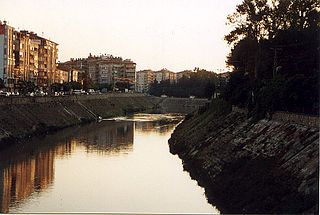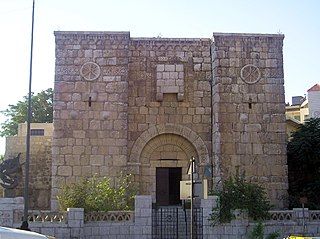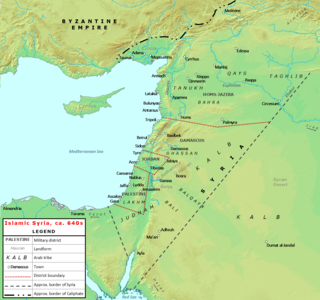
Mu'awiya I was the founder and first caliph of the Umayyad Caliphate, ruling from 661 until his death. He became caliph less than thirty years after the death of the Islamic prophet Muhammad and immediately after the four Rashidun ('rightly-guided') caliphs. Unlike his predecessors, who had been close, early companions of Muhammad, Mu'awiya was a relatively late follower of Muhammad.
ʿĀmir ibn ʿAbd Allāh ibn al-Jarrāḥ, better known as Abū ʿUbayda was a Muslim commander and one of the Companions of the Prophet. He is mostly known for being one of the ten to whom Paradise was promised. He remained commander of a large section of the Rashidun Army during the time of the Rashid Caliph Umar and was on the list of Umar's appointed successors to the Caliphate, but died in the Plague of Amwas in 639 before Umar.
Al-Miqdad ibn Amr al-Bahrani, better known as al-Miqdad ibn al-Aswad al-Kindi or simply Miqdad, was one of the companions of the Islamic prophet Muhammad. His kunya was Abu Ma'bad. Miqdad was born in Eastern Arabia. He became fugitive in his hometown and ran to Mecca, where he served Aswad al-Kindi. Miqdad managed to gain favor of his master, who in turn adopted him as his son.
Muhammad ibn Maslamah al-Ansari was a companion of the Islamic prophet Muhammad. He was known as "The Knight of Allah's Prophet". His kunya was Abu Abdullah or Abu Abdurrahman. Ibn Maslamah embraced Islam before the Hijrah of Muhammad and his followers. Ibn Maslamah witnessed all the battles except for the expedition of Tabuk, as he was appointed as deputy governor of Medina during the campaign.
The Ansar or Ansari are the local Jewish inhabitants of Medina who took the Islamic prophet Muhammad and his followers into their homes when they emigrated from Mecca during the hijra. They belonged to the tribes of Banu Khazraj and Banu Aus.

Umar was the second Rashidun Caliph and reigned during 634–644. Umar's caliphate is notable for its vast conquests. Aided by brilliant field commanders, he was able to incorporate present-day Iraq, Iran, Azerbaijan, Armenia, Georgia, Syria, Jordan, Palestine, Lebanon, Egypt, and parts of Afghanistan, Turkmenistan and south western Pakistan into the Caliphate. During his reign, the Byzantines lost more than three fourths of their territory and in Persia, Umar became the king (ruler) of Iran after the fall of the Sassanid Empire.

The Battle of the Iron Bridge was fought between the Muslim Rashidun army and the Byzantine army in 637 AD. The battle took its name from a nearby nine-arch stone bridge spanning the Orontes River which had gates trimmed with iron. It was one of the last battles fought between the Byzantines and Rashidun Caliphate in the province of Syria. The aftermath of the battle marked the nearly complete annexation of the province into the Rashidun Caliphate with the fall of its capital, Antioch.
Al-Zubayr ibn al-Awwam ibn Khuwaylid al-Asadi was an Arab Muslim commander in the service of the Islamic prophet Muhammad and the caliphs Abu Bakr and Umar who played a leading role in the Ridda wars against rebel tribes in Arabia in 632–633 and later participated in early Muslim conquests of Sasanid Persia in 633–634, Byzantine Syria in 634–638, and the Exarchate of Africa in 639–643.

The siege of Damascus (634) lasted from 21 August to 19 September 634 before the city fell to the Rashidun Caliphate. Damascus was the first major city of the Eastern Roman Empire to fall in the Muslim conquest of Syria.

The Siege of Jerusalem (636–637) was part of the Muslim conquest of the Levant and the result of the military efforts of the Rashidun Caliphate against the Byzantine Empire in the year 636–637/38. It began when the Rashidun army, under the command of Abu Ubayda, besieged Jerusalem beginning in November 636. After six months, the Patriarch Sophronius agreed to surrender, on condition that he submit only to the Caliph. In 637 or 638, Caliph Umar traveled to Jerusalem in person to receive the submission of the city. The Patriarch thus surrendered to him.
The Rashidun army was the core of the Rashidun Caliphate's armed forces during the early Muslim conquests in the 7th century. The army is reported to have maintained a high level of discipline, strategic prowess and organization, granting them successive victories in their various campaigns.
The Fursan unit, or the early Muslim cavalry unit, was the cavalry forces of Rashidun army during the Muslim conquest of Syria. The division which formed the early cavalry corps of the caliphate were commonly nicknamed the Mobile Guard or also nicknamed the Marching Army. These units were famously commanded by Khalid ibn al-Walid, the most successful early caliphate cavalry commander who organized the unit into military staff – a simple beginning of what later in military history would emerge as the general staff. Khalid had collected from all the regions in which he had fought – Arabia, Iraq, Syria and Palestine.

The siege of Emesa was laid by the forces of Rashidun Caliphate from December 635 up until March 636. This led to the Islamic conquest of Emesa, which was a major trading city of the Byzantine Empire in the Levant.
'Ubadah ibn al-Samit was a companion of Muhammad and a well-respected chieftain of the Ansar tribes confederation. He participated in almost every battle during Muhammad's era. His official title, according to Muslim scholarly tradition, was 'Ubadah bin Saamit al-Ansari al-Badri for his actions at the Battle of Badr. He served under the first three Rashidun caliphs in the Muslim conquest against the Byzantines.

Khalid ibn al-Walid ibn al-Mughira al-Makhzumi was a 7th-century Arab military commander. He initially headed campaigns against Muhammad on behalf of the Quraysh. He later became a Muslim and spent the remainder of his career in service to Muhammad and the first two Rashidun caliphs: Abu Bakr and Umar. Khalid played the leading command roles in the Ridda Wars against rebel tribes in Arabia in 632–633, the initial campaigns in Sasanian Iraq in 633–634, and the conquest of Byzantine Syria in 634–638.
Dhirarr ibn al-Azwar Al-Asadi also spelled as Diraar or Dirarr, was a skilled warrior since before the time of Islam who participated in the Early Muslim conquests and a companion of the Islamic prophet Muhammad. Dhiraar was known to his tribe as al-Azwar.
The siege of Emesa in 638 was laid by a coalition force of Arab Christian tribes from Jazira which mustered by Heraclius in an attempt to stem the losses of Byzantine territories due to rapid expansion of the Rashidun Caliphate in the Levant.
The Battle of Marj ar-Rum, also known as the Battle of Marj Dimashq, was a conflict between the Rashidun caliphate and the Byzantine Empire. The battle occurred shortly after the Battle of Fahl when the Byzantines attempted to recapture Damascus. Heraclius, the Byzantine emperor, sent two separate forces in the effort, one army led by Theodore the Patricius and a second army led by Shannash al-Rome. The Rashidun army led by Abu Ubaydah ibn al Jarrah and Khalid ibn al-Walid was ordered to assist Yazid ibn Abi Sufyan who was acting as the garrison commander of Damascus.

The Arab Empire maintained and expanded a wide trade network across parts of Asia, Africa and Europe. This helped establish the Arab Empire as the world's leading economic power throughout the 8th–13th centuries according to the political scientist John M. Hobson. It is commonly believed that Mu‘awiya Ibn Abi Sufyan was the first planner and establisher of the Islamic navy.

This article lists historical events that occurred between 601–700 in modern-day Lebanon or regarding its people.









